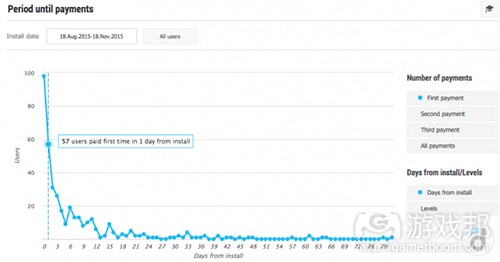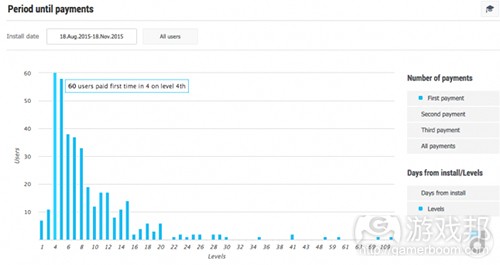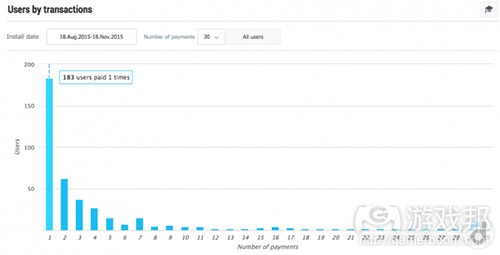如何有效分析付费用户(三)
作者:Vasiliy Sabirov
今天我们将谈论再次消费和转换成付费用户的时间问题。你应该问自己怎样的问题?
用户是在哪一天进行首次消费?第二次消费?第三次消费?
了解用户消费行为能够帮助你更好地规划产品的盈利。这便是传统的产品分析公式方法:
1.明确用户行为模式;
2.找到行为与该模式相关的用户;
3.让这些用户基于模式采取下一个行动。对于你来说这可能像是模式的逻辑延续,而对于用户来说,这则是在对的时间出现的具有针对性的内容。
了解用户何时进行第二次付费,如此你便能够提前提供给他们有趣的活动(或具有针对性的内容)。
举个例子来说,让我们使用devtodev分析系统的报告“付费前的时期”。选择每个用户的首次付费时间(游戏邦注:你也可以选择第二次,第三次或所有付费时间,并且不用考虑序号),确定用户注册时间,并着眼于时间和他们首次付费的分布规律。
我们发现大多数用户的首次付费都是发生在第一天,即在他们注册应用的那天。这意味着我们可以从用户进入应用的第一天便开始规划任何活动。
然而让用户在完成教程后马上购买东西是不合时宜的—-这会让用户觉得这是只关于消费的游戏,并且他们会马上离开游戏。这也是我们会问自己如下问题的原因。
用户是在第几个关卡进行首次购买?第二次购买?以及第三次购买?
再一次地,我们又转向“付费前的时期”这篇报告并选择有关关卡的分布规律。
在这里峰值是出现在第四和第五个关卡中。
因此我们需要识别一个模式,即付费用户主要是在注册的第一天并且是到达第四和第五个关卡的时候开始进行首次消费。
之后我们将能够添加一个与该模式相关的具有针对性的内容到项目中(一款游戏或者一个训练服务)。这将帮助我们提高用户在第一天转换成付费用户的几率。
多少用户只进行一次消费?多少用户重复消费了?在首次消费和重复消费间的分布情况是怎样的?
让我们先着眼于一个小小的建议:结合付费用户参数(付费用户数量)和付费用户比例(在活跃用户中付费用户的比例)并关注于全新付费用户参数,这能够呈现出分析过程中进行首次购买的用户数量。而如果没有首次购买也就不用提重复购买了。
让我们说说重复购买的重要性。Tapjoy评估了一些创造数百万美元收益的应用并明确了他们的一些共同点。
第一个共同点是:在84%的应用中至少有1000名用户在进入应用后的90天内至少进行了三次购买,并且它们的收益都突破了100万美元。
为了帮助你更好地理解基于付费用户的消费次数的付费用户分布规律,我们创造了“基于交易的用户”报告。这将帮助你明确多少用户进行了一次交易,两次交易等等。
第二个共同点是:
如果至少35%的用户进行了第一次消费后又进行了第二次,第三次消费,那么应用便有可能创造出100万美元的收益。
第一次消费的规模通常都较小。你能在“付费用户活动”报告中看到这点:
进行了首次消费的用户只想测试在你的产品中花钱会有什么好处,并且他们并未准备好马上投入更多钱。此外,首次消费同样也会让他们在自己的账号中绑定信用卡。
而最主要的盈利份额还是来自重复消费。
所以如果你想获得最终成功,你的产品必须满足以下条件:
1.应该让用户自己想起进行首次消费,但是你可以通过在适当的时候公开模式并提供有趣的内容去推动他们。
2.不要要求用户在第一次消费时便投入许多钱。第一次消费通常都不会有太多钱。
3.应该让用户觉得自己的投资是有回报的,如此他们便会进行首次购买并继续支付更多钱。
4.你的项目应该让用户自愿支付自己想要支付的金额。每个用户,不管是非付费用户还是鲸鱼用户都必须真正享受你的产品。
5.长期用户留存是出色盈利的关键。如果用户是非付费用户,那么他留在应用中的时间越长,他们消费的可能性便会越高。如果用户是付费用户,他们留在应用中的时间越长,他们便有可能花费更多钱。
(本文为游戏邦/gamerboom.com编译,拒绝任何不保留版权的转发,如需转载请联系:游戏邦)
How to analyze paying users. Part 3. Re-payments and conversion.
by Vasiliy Sabirov
Today we are going to talk about re-payments and about the time of conversion into payment. What questions should you be asking yourself?
On what day, the user makes the first payment? The second? The third?
Understanding of user payment behavior will allow you to better plan monetization of your product. This is the usage of the traditional product analytics algorithm:
Identity the pattern of user behavior;
Find the users whose behavior initially corresponds to this pattern;
Offer these users to take next action from the pattern. For you it looks like a logical continuation of the pattern, and for the user – as a targeted offer at the right time.
Knowing when the user makes the next payment, you can get ahead of it and offer the desired campaign (or targeted offer) at the right time.
For example, let’s use the report “‘Period until payments” by devtodev analytical system. Choose the time of the very first payment (you can also choose the second, the third or all payments, regardless of the serial number), set the period of users registration, and look at the distribution of time of their first payment.
We see that the bulk of the first payments is made in the first days, even at the day of registration of the user. This means that we can safely propose any campaign from the very beginning of user’s staying in the app, even from the first day.
However, offering to buy something, for example, immediately after passing the tutorial would not be quite right – the user decides that the game is based only on donations and, quite likely to immediately leave the application. This is why we ask ourselves the following question.
At what level the user makes the first purchase? And the second? And the third?
Again, we turn to the report “Period until payments” and choose the distribution not by days, but by levels.
Aha! Here is the peak on the fourth and fifth levels.
Thus, we have identified a pattern – paying users primarily make the first purchase on the day of registration at the achievement of levels 4-5.
In the future, we will be able to build into the project (be it a game, or say, a training service) a targeted offer corresponding to this pattern. And it will help us to increase the conversion into paying user on the first day.
How many users make one payment? How many users make repeated payments? How are the sums distributed between the first and repeated payments?
Let’s begin with a little advice. Advice: par with metrics Paying Users (amount of paying users) and Paying Share (proportion of paying users among active audience) pay attention to New Paying Users metric, that shows the number of users that made their first payment during the period analyzed. Without the first payment, there would be no repeated ones.
Speaking about the importance of re-payments. Tapjoy company reviewed the applications that made a million dollars and identified a few common signs.
The first sign: 84% of applications, in which at least 1,000 users made at least three payments during the first 90 days from the date of the first entry, overcame the barrier of $ 1 million.
To help you better understand the distribution of paying users by the number of payments made by them, we, here at devtodev, developed a report “Users by transactions”. It allows you to see how many users made one transaction, two transactions and so on.
The second sign, identified by Tapjoy:
If at least 35% of users made the first payment, and then made the second and the third payments, then the application is likely to make a million dollars.
The first payment is usually small in size. You may see this in the report “Paying users activity”:
Users who make their first payment, only want to test the benefit of the paid use of your product and are not ready to immediately spend large sums. In addition, the first payment is also a reason to link the card to the account, if it wasn’t previously linked.
But the main monetary weight is contained in the re-payments.
So to have financial success, your product must meet the following conditions:
1.The user should come to making the first payment by himself, however, you may help him by revealing the pattern and making an offer at the right time.
2.Do not require a large first payment from the user. The first payment is usually small in size.
3.The user should feel the return on investment, then he would be pleased with the first purchase and willing to pay more.
4.Your product should allow a user to pay as much as he wants. Each user, whether he is a non-paying or a whale (the user with the highest check) must enjoy the use of your product.
5.Long-term retention is the key to a good monetization. If the user is non-paying, the longer he is with you, the higher the probability of the payment is. If the user is paying, the longer he is with you, the more he might pay.
At this, series of articles on the analysis of paying users is completed.
Analyze the behavior of those who are paying you, understand where your money comes from and increase your cash flow.(source:gamasutra)
上一篇:免费游戏中3大最糟糕的游戏体验
下一篇:如何有效分析付费用户(二)











































 闽公网安备35020302001549号
闽公网安备35020302001549号